
Azad Jammu and Kashmir, abbreviated as AJK and colloquially referred to as simply Azad Kashmir, is a region administered by Pakistan as a nominally self-governing entity and constituting the western portion of the larger Kashmir region, which has been the subject of a dispute between India and Pakistan since 1947. Azad Kashmir also shares borders with the Pakistani provinces of Punjab and Khyber Pakhtunkhwa to the south and west, respectively. On its eastern side, Azad Kashmir is separated from the Indian union territory of Jammu and Kashmir by the Line of Control (LoC), which serves as the de facto border between the Indian- and Pakistani-controlled parts of Kashmir. Geographically, it covers a total area of 13,297 km2 (5,134 sq mi) and has a total population of 4,045,366 as per the 2017 national census.

The Indo-Pakistani war of 1947–1948, also known as the first Kashmir war, was a war fought between India and Pakistan over the princely state of Jammu and Kashmir from 1947 to 1948. It was the first of four Indo-Pakistani wars between the two newly independent nations. Pakistan precipitated the war a few weeks after its independence by launching tribal lashkar (militias) from Waziristan, in an effort to capture Kashmir and to preempt the possibility of its ruler joining India.

Muzaffarabad is a city in Pakistani-administered Azad Kashmir in the disputed Kashmir region. It is the largest city and the capital of Azad Kashmir, which is a Pakistani-administered administrative territory.
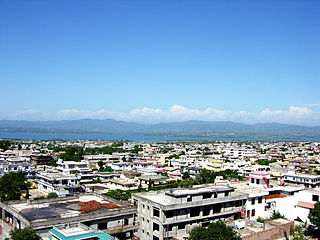
Mirpur, officially known as New Mirpur City, is the capital of Mirpur district located in Azad Kashmir, Pakistan which has been subject of the larger Kashmir dispute between Pakistan and India since 1947. It is the second largest city of Azad Kashmir and the 74th largest city in Pakistan.

Operation Gibraltar was the codename of a military operation planned and executed by the Pakistan Army in the territory of Jammu and Kashmir, India in August 1965. The operation's strategy was to covertly cross the Line of Control (LoC) and incite the Muslim-majority Kashmiri population's uprising against the Indian Government. The military leadership believed that a rebellion by the local Kashmiri population against Indian authorities would serve as Pakistan's casus belli against India on the international stage.

Rawalakot is the capital of Poonch district in Azad Kashmir, Pakistan. It is located in the Pir Panjal Range.
The following is a timeline of the Kashmir conflict, a territorial conflict between India, Pakistan and, to a lesser degree, China. India and Pakistan have been involved in four wars and several border skirmishes over the issue.
Khurshid Hasan Khurshid (Urdu: خورشید حسن خورشید) pronounced [xu:r'ʃi:d ɦəsəɳ xu:r'ʃi:d], popularly known by his acronym, K. H. Khurshid, was the Private Secretary of Muhammad Ali Jinnah, the first Governor-General of Pakistan. He served Jinnah from 1944 until his death in 1948. Khurshid was the first elected President of Azad Jammu and Kashmir from 1959 to 1964. He was also the instigator of the Constitution of Azad Kashmir.
Pallandri, also spelled Palandri, originally Pulandari, is a Tehsil which serves as the administrative capital of Sudhanoti district of Azad Kashmir. It is located at latitude 33° 42′ 54″ N, longitude 73° 41′ 9″ E, 90 km (56 mi) from Islamabad, the capital of Pakistan. It is connected with Rawalpindi and Islamabad through Azad Pattan road. The main tribe of Pallandri is the Sudhan tribe. Here in Palindri the first Government of Sidhnuti Azad Kashmir on October 4,1947 was established
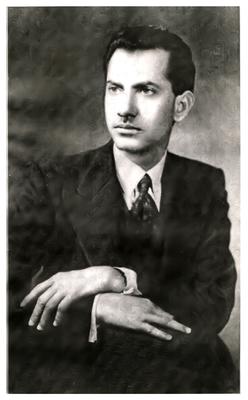
Sardar Muhammad Ibrahim Khan was a Kashmiri revolutionary leader and politician, who led the 1947 Poonch Rebellion against absolute rule of the Maharaja in the state of Jammu and Kashmir and played a key role in the First Kashmir War, supporting Pakistan. He served as the President of Azad Kashmir for 13 years across four non-consecutive terms and still remains the longest-serving president of the state, since its establishment.
Sudhan is one of the major tribes from the districts of Poonch, Sudhanoti, Bagh and Kotli in Azad Kashmir, allegedly originating from Pashtun areas. The Sudhan Pathans who settled in Azad Kashmir are mainly an important and major branch of the Saduzai tribe who migrated from Afghanistan in the 14th century AD and founded the present-day Azad Kashmir region of Sudhanoti and ruled here for hundreds of years.

The Sudhanoti District, meaning the "heartland of Sudhans" or "Sudhan heartland"),
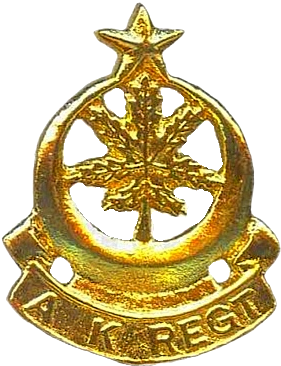
The Azad Kashmir Regiment, also known as AK Regt, is one of the six infantry regiments in the Pakistan Army. The regiment takes its name from Azad Kashmir, which is the Pakistani-administered territory of the Kashmir region. As per the order of seniority, it is the fourth regiment, but was the first to be raised after the independence of Pakistan from British colonial rule. Its regimental centre is located at Mansar camp in Attock District, on the border of Punjab and KPK provinces. The regiment has participated in all major and minor operations and wars fought by the army. Notable commanders of the regiment include lieutenant general Haroon Aslam, an ex-commander of Pakistan Army Special Service Group who led the SSG operation in Swat in 2009, and lieutenant general Hidayat ur Rehman, who commanded Operation al-Mizan and operation Zarb-e-Azab in FATA from 2014 to 2016.
Gunupati Keshava Reddy (1923–1987), better known as G. K. Reddy, was an Indian journalist who attained national and international acclaim for his articles and news stories. He was a major contributor to the newspaper The Hindu for more than two decades, becoming a household name with his front-page articles every day. Reddy was also involved in the nascent Kashmir conflict in the early years of his career, working for a Kashmiri newspaper in Srinagar and later the Azad Kashmir provisional government.

The history of Azad Kashmir, a part of the Kashmir region administered by Pakistan, is related to the history of the Kashmir region during the Dogra rule. Azad Kashmir borders the Pakistani provinces of Punjab and Khyber Pakhtunkhwa to the south and west respectively, Gilgit–Baltistan to the north, and the Indian union territory of Jammu and Kashmir to the east.
Malik Munawar Khan Awan was a Major rank officer in the Pakistan Army, whose career had begun in the British Indian Army and included spells in the Imperial Japanese Army and the revolutionary Indian National Army that fought against the Allies in World War II where he commanded 2nd INA Guerrilla Battalion during famous Battle of Imphal. He received a gallantry award for his work during Operation Gibraltar in 1965.
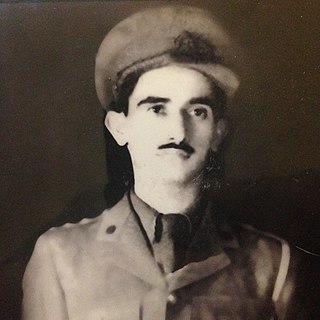
Khan Muhammad Khan commonly known as Khan of Mong, was a Captain in the British Indian Army during the World War II. After demobilisation, he served as a rebel leader during the First Kashmir War. He is credited with the capture of Mirpur,even though the real action was carried out by Pakistan's PAVO Cavalry.. He was also allegedly involved with the Rawalpindi Conspiracy and the Poonch Uprising.

After the Partition of India, during October–November 1947 in the Jammu region of the princely state of Jammu and Kashmir, many Muslims were massacred and others driven away to West Punjab. The killings were carried out by extremist Hindus and Sikhs, aided and abetted by the forces of Maharaja Hari Singh. The activists of the Rashtriya Swayamsevak Sangh (RSS) played a key role in planning and executing the riots. An estimated 20,000–100,000 Muslims were massacred. Subsequently, many non-Muslims were massacred by Pakistani tribesmen, in the Mirpur region of today's Pakistani administered Kashmir, and also in the Rajouri area of Jammu division.
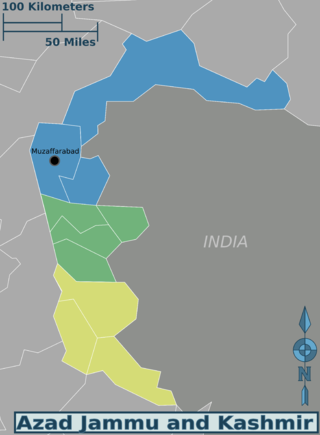
In spring 1947, an uprising against the Maharaja Hari Singh of Jammu and Kashmir broke out in the Poonch jagir, an area bordering the Rawalpindi district of West Punjab and the Hazara district of the North-West Frontier Province in the future Pakistan. It was driven by grievances such as high taxes, the Maharaja's neglect of World War veterans, and above all, Muslim nationalism with a desire to join Pakistan. The leader of the rebellion, Sardar Muhammad Ibrahim Khan, escaped to Lahore by the end of August 1947 and persuaded the Pakistani authorities to back the rebellion. In addition to the backing, Prime Minister Liaquat Ali Khan authorised an invasion of the state, by the ex-Indian National Army personnel in the south and a force led by Major Khurshid Anwar in the north. These invasions eventually led to the First Kashmir War fought between India and Pakistan, and the formation of Azad Kashmir provisional government. The Poonch jagir has since been divided across Azad Kashmir, administered by Pakistan and the state of Jammu and Kashmir, administered by India.
PC Pak Search Sudhan Operation was a Pakistani military operation of the 1955 Poonch uprising. The first major operation of the Pakistan Army inside Pakistan, it was conducted against Sudhan tribal insurgents in the Sudhan-majority Sudhanoti, Poonch, Bagh, and Kotli Districts of Azad Kashmir.













